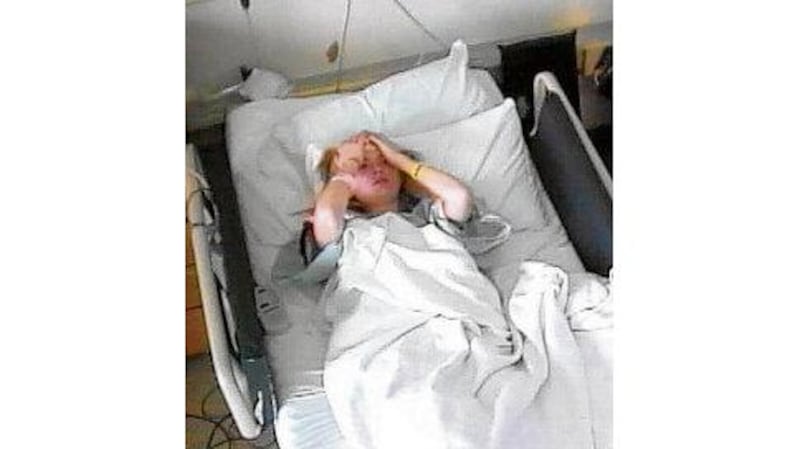Susannah Cahalan found herself in a hospital with no memory of how she got there, or why
‘My first serious blackout marked the line between sanity and insanity. Though I would have moments of lucidity over the coming days and weeks, I would never again be the same person.”
So writes award-winning New York Post journalist Susannah Cahalan (28) in her fascinating new book Brain on Fire. It details a time in her life several years ago when for weeks she knew something was not right with her then 24-year-old body. Her moods had changed and Cahalan put it down to a bad flu or the stresses of life as a young reporter in New York.


After her first identifiable seizure, everything in her life changed when she eventually found herself in a hospital with no memory of how she got there, or why. A succession of doctors and specialists struggled to identify her illness as one of the rarest auto-immune diseases in the world and it took a brilliantly personable specialist using just a pen and paper to unlock the mystery.
The disease in question is anti-NMDA-receptor auto-immune encephalitis and, when she was eventually diagnosed, Cahalan became only the 217th person in the world to be officially linked with the illness.
The disease resulted in her immune system attacking her brain, and the seizures, psychotic episodes and hallucinations that accompany it have led doctors to speculate it may have been the real cause of so-called “devil possessions” through the ages.
In her book, Cahalan describes what she calls “my month of madness” and reconstructs the period of her illness through interviews, medical records, hospital videos and journals.
As she was passed from specialist to specialist and the attempted treatment costs spiralled (eventually costing in the region of $1 million (€748,000), for which thankfully she had insurance) Cahalan’s illness remained a mystery to medics.
Some of the medical staff she met thought she may have had a combination of bi-polar and schizophrenia.
Animal-like state
Several weeks after her seizures began, Cahalan had turned into an animal-like state, kicking and punching those close to her, as her family and partner looked on helplessly. Her medical saviour would arrive in the guise of Dr Souhel Najjar, a neurologist at New York University’s medical centre. “I had a spinal tap and additional white blood cells showed up,” she explains.
“Meanwhile, I met Dr Najjar and he asked me to draw a clock and I drew all the numbers one to 12 on the right side of the drawing, but I left the left-hand side of the page blank. This proved to him that there was a problem with the right side of my brain and my left field of vision was impaired. He said at the time he thought it was encephalitis, but he needed to confirm there was inflammation in my brain. They did a brain biopsy and it was confirmed.”
The disease is treatable with a combination of steroids and immune therapy. The treatment suppresses the immune system so it cannot create harmful antibodies that attack the NMDA receptors in Cahalan’s brain.
Possibility of relapse
To get rid of certain antibodies, she received intravenous immunoglobulin (IVIG) and plasmapheresis treatment, which involved injecting plasma from 1,000 donors into her system. She says she has had about 20 IVIG transfusions (each costing about $20,000) and she now considers herself cured from her illness, although relapse is always a possibility.
As well as her journalism work, Cahalan has become an ambassador for the Encephalitis Society. She returned to work seven months after her illness, but says it took her a year and a half to fully recover.
The book came about after she wrote about her experiences in the New York Post and it struck a chord with readers.
Brain on Fire is not just another tell-all illness memoir, however; it is an intriguing scientific journey into one of the world’s lesser-known diseases.
Finding out what happened
“I didn’t want to write a memoir at 24,” Cahalan says. “The science was very important to me and I wanted to get that right. It had to be a human story and, for me, I was just as interested in finding out and piecing together what happened to me, from records available, as anyone else may be. It’s pretty interesting the things I learned when I interviewed others about my mental state at that time.”
Towards the end of the book, Cahalan talks about the original article she wrote for the New York Post on her illness, following encouragement from her editor. After it was published, her inbox was filled with hundreds of emails from readers, many of whom had been diagnosed with different kinds of auto-immune illnesses.
“The words of people I spoke with kept me up at night,” she writes. “Why me? Why did my antibodies decide to attack? Why was I able to then recover? I live with that constant refrain – not of self-pity but the real question of why my body decided to turn on itself. Then again, why does this happen to anyone?”
Brain on Fire by Susannah Cahalan is published by Particular Books.
[ susannahcahalan.comOpens in new window ]
Final diagnosis: Form of encephalitis
Anti-NMDA-receptor auto-immune encephalitis is a disorder where the cells of the immune system attack NMDA receptors in the brain.
Generally when this happens patients will experience flu-like symptoms, some mood changes and then psychosis, hallucinations and frequent seizures.
It affects mostly young women, although more recently it has also been found in children and males.
It can be discovered through blood tests, and immune therapies are used to treat the disease.


















